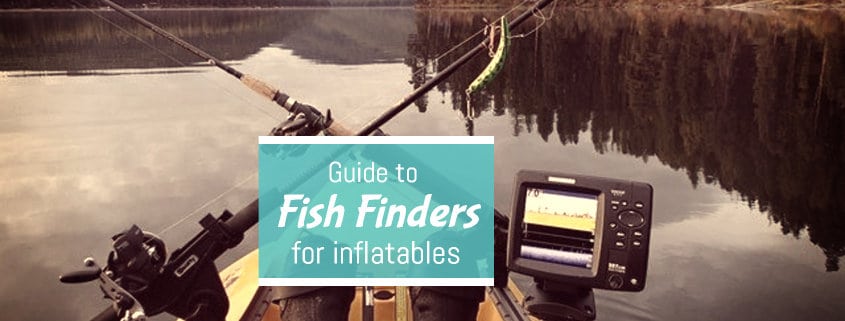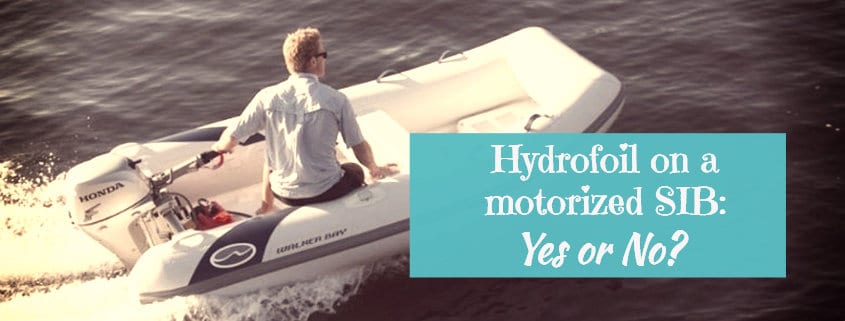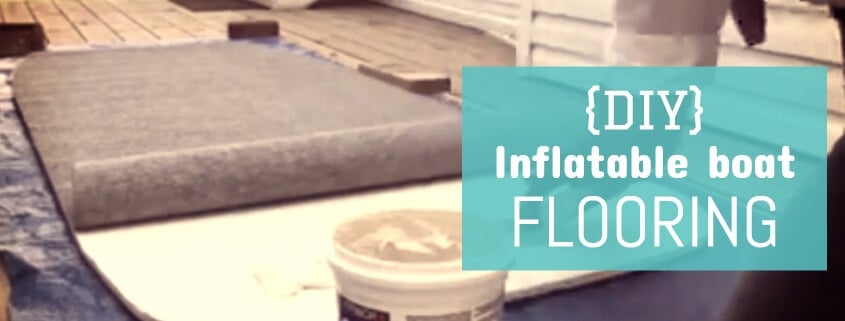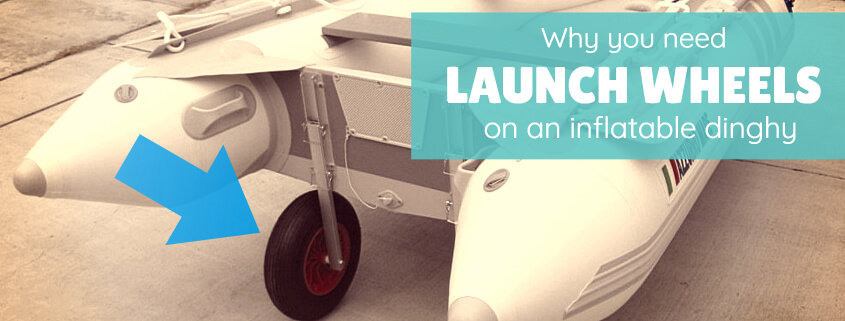Fish finders have helped several of my angler friends excel at their hobby. If you are new to fishing, are facing issues locating fish or you are not able to steer clear of no-fish spots, a fish finder will come in extremely handy.
The device may not necessarily make you an expert angler overnight, but you would certainly be on the path to becoming one.
Fish finders come in different shapes and sizes, and pack various tech. If you are looking to buy one for yourself, you should get to know the tool in detail and how to use it. This article intends to help you do just that.
Contents
How Does a Fish Finder Work?
A fish finder incorporates science that a sonar device is based on. It produces a sound and then listens to the echoing that follows. The reverberation helps the device ascertain how far an object is.
A so-called transducer emits the sound and listens for the echo.
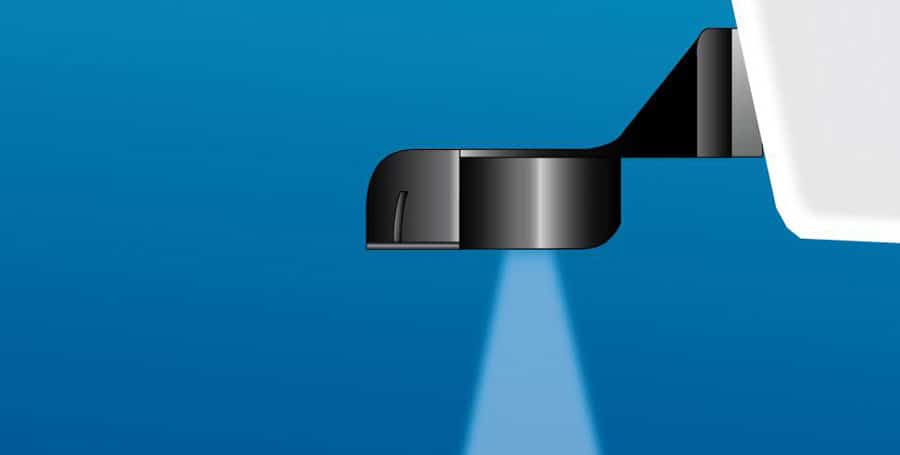
By employing multiple sounds, fish finders not just help determine if there are fishes present in the vicinity, but also where the bottom is, whether there is debris, underwater obstructions, or any other object the fishes are hiding under.
The more advanced fish finders can also create approximate images of what’s underneath a surface. The picture is essentially based on the object the sound rebounded off.
Due to the highly mobile nature and unique shape of fish, the fish are represented only as icons or symbols. This, however, still comes in quite handy with gauging the fish’s real-time location, and also getting a fairly decent idea of their size.
To ensure the signals received are not false, the waves that come in after being reflected from the fishes get displayed in a unique way, when compared to the reflections coming from corals, stones, or other obstructions. Echoes differ in form and size when the water has fishes and when there are no fishes in the water. Objects other than fishes are exhibited using different symbols.
The majority of advanced fishfinders employ multiple frequencies to provide you an enhanced view based on the situation:
- A higher frequency conjures a cone angle that’s narrower than normal, offering excellent detail levels.
- Lower frequencies provide greater depth penetration. However, the longer-range limits the sensitivity of the device.
The integrated GPS navigation, compasses, and marine radar found in the newer fishfinders help you trace your path.
Moreover, the GPS integration lets you have an outline of the location and plot sites so that you could return to your starting point without much trouble.
They also offer various other information, such as water temperature and the speed at which your boat is moving.
The 2 types of fishfinders
Based on the type of fishing you do, you should consider choosing between two major fish finder types: side scan and down scan.
The down-scan finder scans right underneath your boat.
The side-scan finder, as the name suggests, lets you scan the sides of your boat for fish, as well as under your boat. Side imaging fish finders use two sonar beams. These beams are aimed out to the sides instead of downwards, and can thus sweep a larger area.
Fitting side-scan fish finders onto inflatable watercraft is problematic though.
Best Fish Finders for Inflatable Boats
There are multiple companies making fish finders. The different models vary in their features, size, function, and various other aspects. The following are the four most popular fish finders you can find for sale.
| Fish finder | Description | Features | Details | |
|---|---|---|---|---|
| 1. | 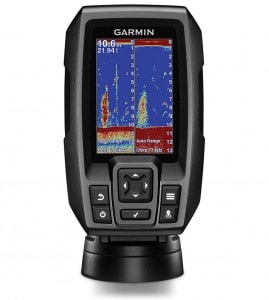 | Best Value Garmin Striker 4 In terms of bang for buck, the Striker 4 is hard to beat. For a low price, you get features that would cost much more with other brands. | - 3.5" color display - GPS - CHIRP sonar - Max depth: 1,600 ft freshwater, 750 ft saltwater | Details |
| 2. | 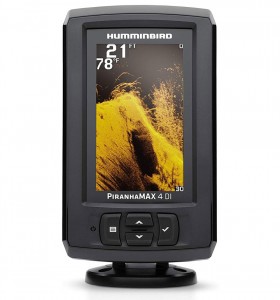 | 2nd choice Hummingbird PiranhaMax DI This is also an accurate fishfinder, but unlike the Striker 4, it does not have GPS and CHIRP technology. The screen is slightly larger though. | - 4.3" color display - Dual-beam sonar - Max depth: 600 ft | Details |
| 3. | 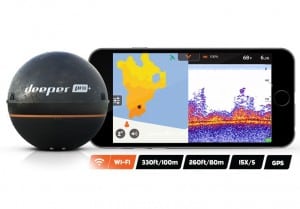 | Castable Deeper PRO+ Smart Sonar This smart fishfinder synchs with your phone, so your phone will be the screen. You can cast from anywhere and get accurate readings, so you can use it from shore and ice fishing as well as you boat. | - Phone synch - GPS mapping - Dual-beam sonar - Max depth: 260 ft | Details |
| 4. | 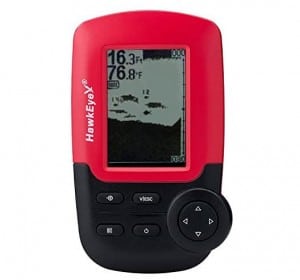 | Portable HawkEye FishTrax 1X This small fish finder is a good option if you need portability. It is accurate at what it does, but does not have the advanced features that more expensive fishfinders do. | - Dot matrix display - 2" x 1" screen - Dual beam - Max depth: 240 ft | Details |
Here are the details on each.
Garmin Striker 4
Pros
Cons
The GARMIN Striker 4 is a super-portable, easy-to-install, and budget-friendly device for fishing in both shallow and deep water. The integrated display provides good-quality images to let you know exactly what’s happening under the water.
Despite being an entry-level fish finder, the Striker 4 packs in a fairly decent amount of premium features, such as IPX7, GPS, and Chirp tech:
- The IPX7 waterproof rating means the device could withstand immersion up to a meter for a maximum of 30 minutes.
- The GPS functionality for docks helps you find your way when you feel lost.
- The CHIRP sonar transducer ensures the smoothest and cleanest water flow to make sure you get the best possible images.
The transducer also shows your boat speed and water temperature.
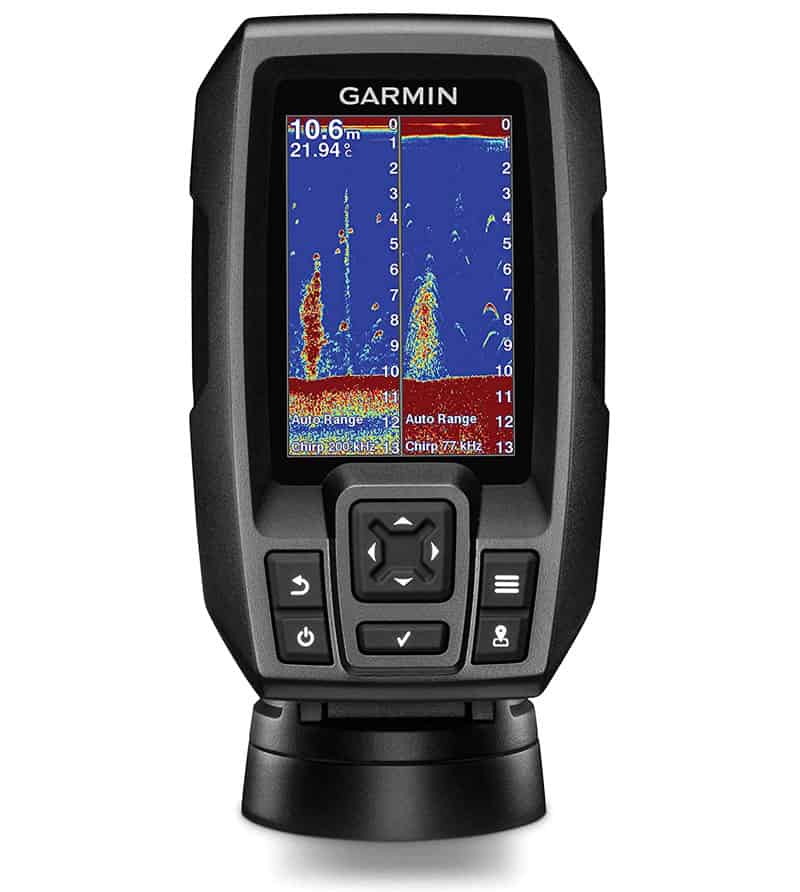
Garmin Striker 4

Great for inflatable boats
Best Fish Finder
The Striker 4 is the best value fish finder you can get for inflatable boats. It has all of the features much more expensive models have at a very good price.
Check today’s prices on:
Hummingbird PiranhaMax DI
Pros
Cons
The Hummingbird 410060-1 isn’t a fish finder that does something out of the ordinary. However, it stands its own because it does what it does extremely well. Moreover, it comes at a fairly affordable price. It’s a budget-friendly, easy-to-set-up device that easily spots fishes 320 feet underneath your boat. The device also reads water temperature with a 99 percent accuracy rate. The tool lets you seamlessly switch between Celsius and Fahrenheit while measuring temperatures. Its down-imaging capabilities are remarkable, which means differentiating a rock from a fish shouldn’t be much of an issue.
The transducer is integrated with the display and directly goes beneath the boat at an angle of 180 degrees. The 4-inch display is monochrome. You have the option to have it in grayscale or as color. The transducer comes with a temperature reader too. The clamp is adjustable and could be fixed to pretty much any part of your boat.
Deeper PRO+ Smart Sonar
Pros
Cons
The Deeper PRO+ Smart Sonar is a solid fish finder for different kinds of fishing. Unlike traditional fish finders, you need not mount this floating sonar to your boat. It’s not just extremely functional and handy but is also fairly inexpensive. Since you need not attach it to your boat, you may catch fishes without actually entering the water. The Deeper PRO+ checks water temperature and reads the water depth like every other fish finder. The casting range is approximately 330 feet, and the depth range is close to 260 feet.
The Deeper PRO+ Smart Sonar is extremely lightweight and compact. You may even carry it in your backpack or jacket pocket. The casing is waterproof and there are three attachments on its exterior. The device helps locate and catch more fish because it’s designed to be highly user-friendly. The connected app lets you in on fish peak periods and lunar dates.
HawkEye FishTrax 1X
Pros
Cons
Marginally bigger than a compact modern-day smartphone, the HawkEye FishTrax 1X snugly fits in your hand.
Despite being relatively small, it comes with a proper transducer that could be utilized as a transom-mounted or a shore fishing unit. It could also come in handy with ice fishing. The product package comes with the transducer. The accessories for mounting the finder the way you would like to are optional.
It’s powered by four AAA batteries that should come good for a maximum of 30 hours.
The FishTrax functions on two frequencies. For deeper water, it uses 83 kHz. And for shallower water, it employs 200 kHz. The range to gather readings is 1.5 feet to 240 feet, which should be serviceable for most kinds of fishing styles and requirements.
How to Mount a Fish Finder & Transducer on an Inflatable Boat?
Unlike setting it up with traditional boats, fish finders cannot be screwed onto the console of an inflatable boat. There are different ways you can affix the fish finder to these boats. The following are the most common methods.
Strap-on mounting
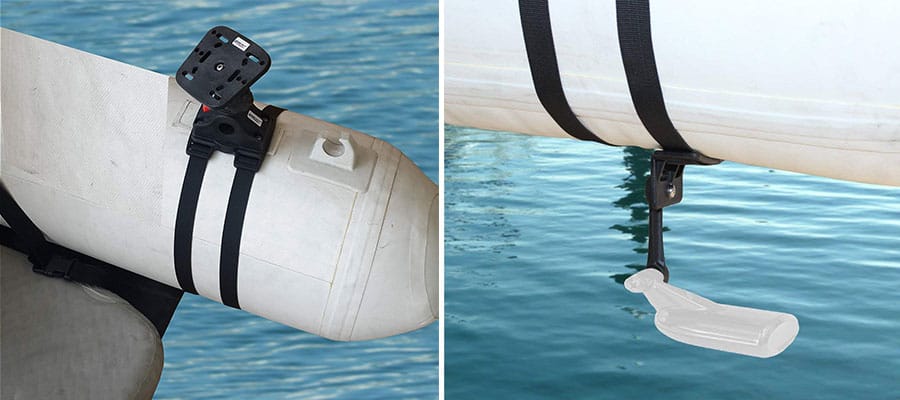
Using a robust strap to mount fish finders onto an inflatable tube is a popular option. Fish finder straps are universal or work with any size of inflatable boats. The strap used is usually made of polypropylene.
You can mount the screen on the top of the pontoon, and the transducer on the bottom very easily.
The Scotty Strap Mount #268 is available for this purpose on Amazon here, and plays nicely with all other Scotty mount products.
Transom mount options for SIBs with a Transom
If your SIB has a transom, you have a number of options for mounting your transducer.
Screw mounting
The most reliable way is to use screws of course. This requires drilling your transom, which some people don’t like to do.
The screwed holes could also develop leaks, so make sure you know what you are doing if you got this route.
To tell you the truth, in all my years of boating, I have never screwed anything into my transoms.
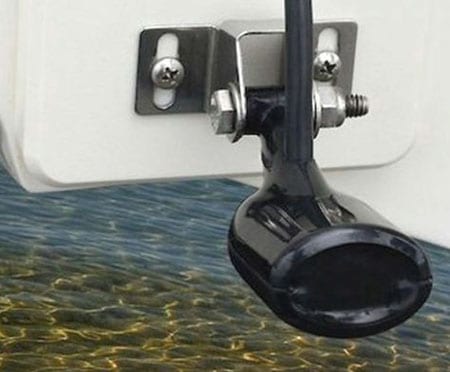
Suction cup transom mount
You can also use a suction cup, like this one from Hawkeye.. Just know that the suction cup method is not the best for high-speed boating, but should be fine when you’re progressing at slow speeds.
You need to make sure you attach the suction cup to a non-porous, straight surface. If you don’t, the suction cup could release while on the water.
This happened to me once, you notice it right away as the fish finder screen goes berserk. You don’t lose the transducer, since it is attached with a cable, but it’s just a pain.
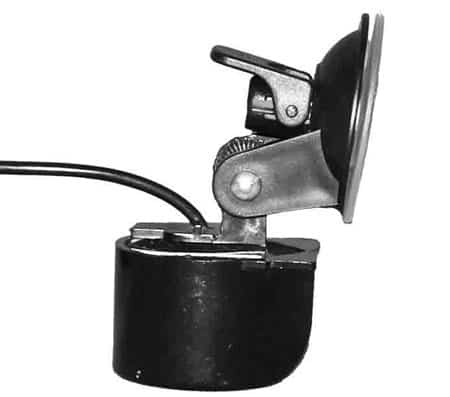
Stern Pad (Transom Saver)
A good alternative is to use the Stern Pad (transom saver). This is a good way to go, as it provides a lasting bond without the use of screws. Check it out here.
Tests carried out on the Transom Saver have shown that they hold for approximately 10 years. You simply glue it on, and you can screw things into the Stern Pad.
A very important thing to note with the Stern Pad is that you need to use marine grade screws that will penetrate 1/2″ into the pad. The thickness of the Standard pad is 0.75″, that of the Jumbo pad is 1″. Using screws that are too long will screw through the pad and either screw into your boat’s transom, or push the pad off of your boat.
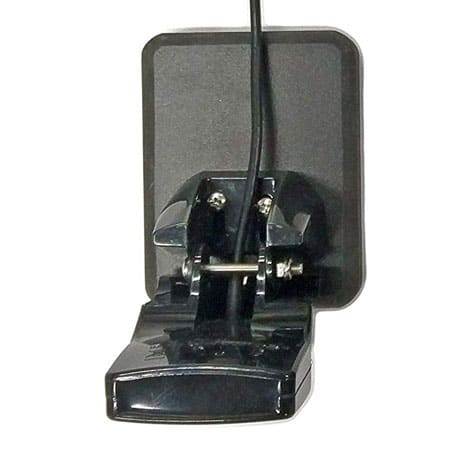
Magnetic transducer mount
You can also use a magnetic transducer mount from FishFinderMounts.com. This is a pretty cool solution for a transom with thicknesses up to a 1/4″ inch.
You basically have big magnets attracting each other through the transom.
Not just for science geeks.
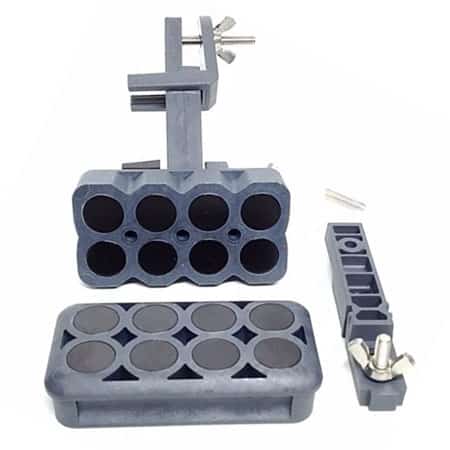
Glue-on Mount
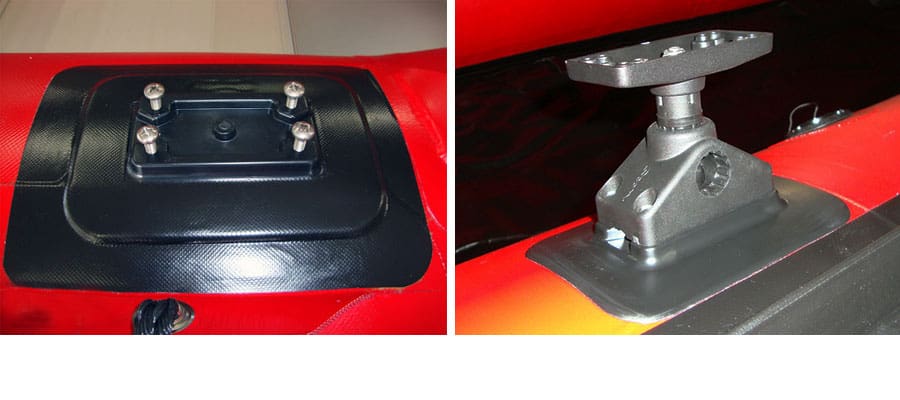
A glue-on mount is a great addition to any inflatable boat, tube or kayak. A glue-on mount is basically a pad you glue onto the tube of your watercraft, to which you can attach a number of things. In our case, a fish finder screen and transducer, but you can mount anything with the use of specialized adapters. This includes anchor locks, fishing rod holders, oar holders, and even cup holders 🙂
When it is time for deflating and transporting your boat, you can easily break down and take the mounted object off. The glue-on base stays on the tube forever.
You will need to get:
- the glue-on mount base
- the adapter to secure your screen to
- and another base and adapter if you want to mount your transducer as well
Check out the Scotty mounts store for all of this.
Mount Transducer onto Trolling Motor
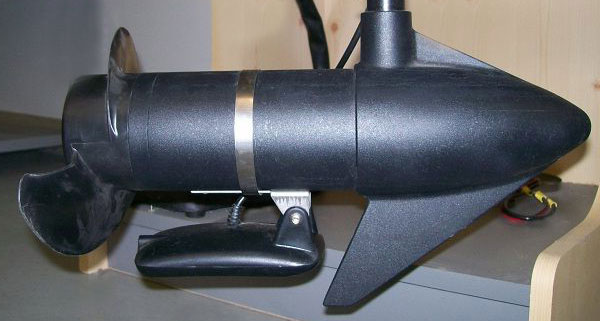
Mounting the transducer onto the electric trolling motor is pretty straightforward. Just make sure you use a mounting bracket.
The transducer is attached to the bracket which comes with a clamp. The clamp could be manually tightened to securely fasten it to transom.
Clamp + Pole Fish Finder
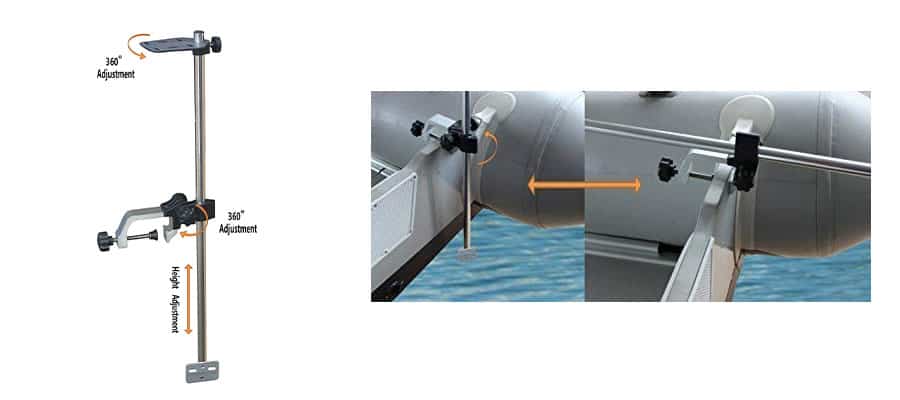
If you have a transom, you can get the above clamp and pole as a product bundle to mount your fish finder. The clamp is portable, and the telescopic pole is usually 24 to 40 inches in length.
The mount is multi-directional, and you can clamp it pretty much anywhere, with zero wiring or rigging, or even a mounting transducer.
BroCraft makes one for about $60, you’ll find it here.
Floatable Sonar
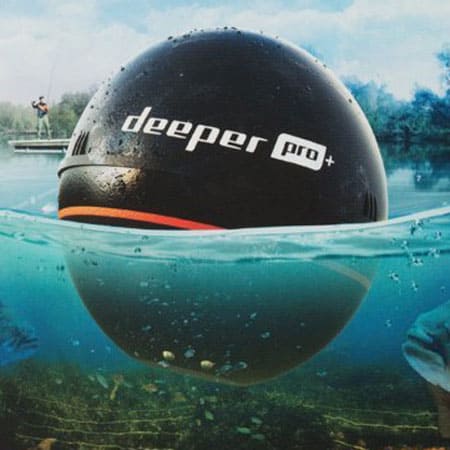
Floatable sonars are arguably the most portable fish finders available for inflatable boaters and kayakers. These floatables connect to your Android or iOS smartphone through a Wi-Fi hotspot, for easy synchronization.
You can tie the floatable onto your line, and cast with it. The device actually maps out the lake as you reel it back in, and you can save these maps as well.
The range of communication is usually a few hundred feet, but it could be more or less based on the brand of floatable pod you use.
Except for the form-factor and unique functionality, a floatable sonar comes with all the features that you would associate with a typical fish finder, including a GPS receiver.
Can You Catch More Fish with a Fish Finder?
A fish finder helps you find fish in a lake. IF you can catch the fish you end up locating, then the fish finder theoretically helps you catch more fish.
To actually catch fishes using a fish finder, you need to keep a few things in mind:
- Time of the day – Fish feed at various times during the day. They will bite easier during their mealtime.
- Water temperature – Generally, you will be able to catch a lot more fishes during warm weather conditions. During colder days, the catch wouldn’t be the best, since the fishes would not be there in their regular spots and will invariably move deep in the water close to the bottom of the lake. You’ll, therefore, have to use different kinds of lures.
- General environment – Learning to recognize where you are fishing goes a long way. Do you know exactly what is under your boat? If you can answer yes, you will be able to adapt your strategy and catch more fish.
- What they’re like when they swim as a group and loiter solo.
The fish finder will help you skip locations that are devoid of fishes, which is a big deal! You would, as a result, not spend too much time and effort scouting certain spots in vain.
By eliminating locations where there are no fish and observing the movement of fishes during specific periods of the day or around a lake, you can effectively ascertain where to lay the trap or throw in the bait.
Learning to tune a fish finder’s sensitivity levels is a good idea. The sensitivity basically determines the amount of information you would be able to get from your fish finder.
But you want to keep things simple at first.
Fish finders usually come with a ton of settings and features. If you’re just getting familiar with fish finders, it’s recommended you stick with the basic settings. You need to know how to locate weed and rocks, adjust the finder’s depth, spot fish, etc. Advanced settings can be explored once you get the hang of the basics.

